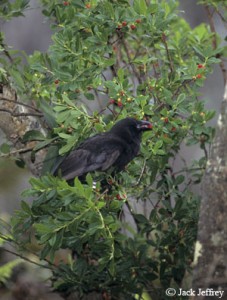History
ʻAlalā are the sole surviving member of the corvid family in Hawaiʻi. Due to a variety of threats in the wild, these birds are critically endangered — efforts are ongoing to return these birds to native forests, beyond captive breeding facilities.
Timeline of the decline of the ʻAlalā population in the wild:

Before Western contact- Up to five species of corvid found on most main Hawaiian islands
1890s – Found throughout its historic range
1900s – Declines already observed
1950s – Only small areas of the historical range occupied by ʻalalā
1976 – Only 76 birds, 3,000 – 6,000 ft. el., 4 areas: Hualālai, Hōnaunau, Honomalino, Kaʻū Forest Reserve
1991/1992 – 1 at Hualālai, 12 at Hōnaunau/McCandless Ranch
1993-1998- Captive ʻalalā released
2002 – A single pair of ʻAlalā was last observed in 2002 in South Kona
2016-2019- 29 ʻAlalā released in Puʻu Makaʻala Natural Area Reserve on Hawaiʻi Island
2020 – Five surviving released birds are returned to conservation breeding program. Planning for future release ares on Maui Nui and Hawaiʻi Island begins.
2024 – Maui Nui release of five ʻalalā into the forest on the slopes of Haleakalā.
ʻAlalā play an important ecological role in Hawaiian forests. ʻAlalā are seed dispersers for many native plant species, eating the fruits and berries of these plants and distributing them throughout the forest. Without ʻalalā on the landscape, these native plants, important components of healthy native forests, struggle to regenerate.
